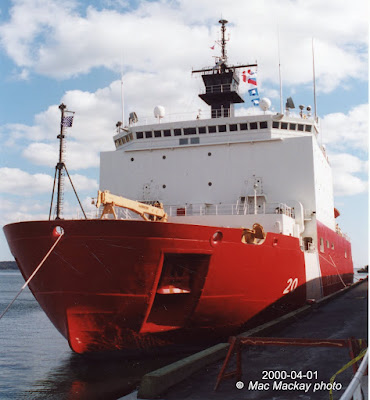 1. Louis S. St-Laurent clear of the Novadock at noon time today, and headed for BIO.
1. Louis S. St-Laurent clear of the Novadock at noon time today, and headed for BIO. 2. Louis shows the shape needed to make way in the arctic.
But if you think we have problems, they are nothing compared to the US Coast Guard. They have only one operational polar class icebreaker, USCG Healy, which was working on the joint venture mission with Louis S. St-Laurent in September. It also had to return home. Both the USCG's other polar icebreakers are out of service. USCG Polar Sea had an engine melt-down in 2010 and will be decommissioned by the end of this year. Its sister Polar Star is in a life extension refit and will not be back in service until 2013. It will also cannibalize parts from its sister to complete the refit, meaning that Polar Sea will never be refitted.
3. USCG Polar Star in Halifax. She had to go east about to reach her Seattle base in 1988 due to heavy ice in the western arctic. The ship is powered with 6 diesel/electric units and 3 gas turbines. In gas turbine mode she develops 60,000 shp continuous, 75,000 demand shaft horsepower.
The USCG also has responsibilities in the antarctic, but Healy is not powerful enough to go there, so the USCG is in a pickle. They have apparently chartered the sister ship to CCGS Terry Fox, the Vladimir Ignatyuk for the arctic, but it is a light displacement ship and doesn't have the weight to battle through thick ice, so it won't be heading south.
4. USCG Healy in Halifax on her maiden voyage. Built in New Orleans, she took the northern route to reach Seattle. She can produce 30,000 shp with her 4 x diesel/ 4 x alternator/ 2 x electric motor system. That's good for 4.5 feet of ice continuous.
Even the Russians are having to spend big money to keep their fleet in service. As one commentator said, it's a great time to be in the icebreaker repair business. Halifax Shipyard has certainly been in the forefront of keeping Louis S. St-Laurent in service since it went into service in 1969 (built by Canadian Vickers in Montreal.) The multi-year mid-life refit project (1987-1993) saw the ship get a new bow, and a new propulsion system. Its original 3 steam turbine/9 generator*/ 3 electric motor system developed 27,000*shaft horsepower. The new system of 5 diesels/ 3 generators/ 3 electric motors gives something in the same range.
[* corrected after initial posting-see Comments. 110% = 29,700 shp]
[* corrected after initial posting-see Comments. 110% = 29,700 shp]
Addendum: It is difficult to get the right info on power for icebreakers, as "Installed Horsepower" is often used, i.e. the total of all the bhps of the engines-but this is not the delivered horsepower at the shafts. Some sources do not distinguish between ihp and shp, but there is a loss, particularly in diesel-electrics or steamturbine-electrics , which should be accounted for. As with tugs, all horsepower ratings should be taken with a grain of salt.
.





Regards to your info about the original steam plant on the CCGS LOUIS S. ST LAURENT, there were 3 main turbines with 9 generators, 3 per turbine. Also each propulsion motor was rated at 9000 SHP for a total of 27000 SHP at 100% rated power. The LOUIS could also go to 110% for short periods of time if the stars were all aligned & nothing fell apart or blew up!
ReplyDelete